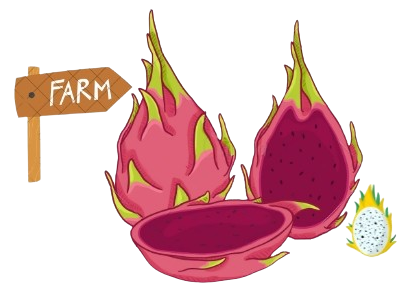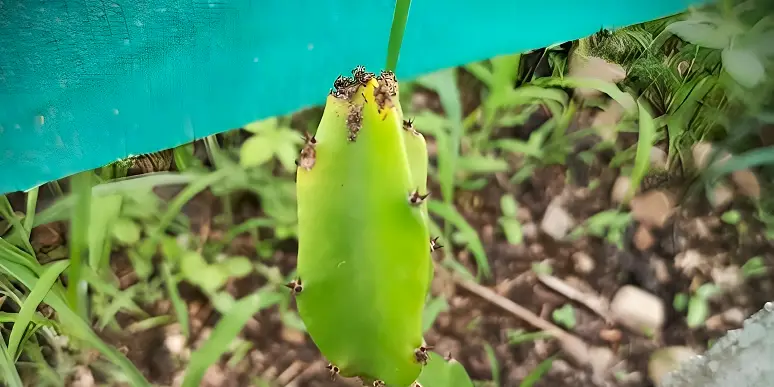If you’re growing dragon fruit, you already know how much effort and money goes into it. But even after doing everything right — the soil prep, trellising, irrigation — one small pest can cause big trouble
Most new farmers don’t expect it, but during fruiting season, this tiny insect can spoil a major chunk of your harvest if you’re not paying attention. That’s why identifying and controlling fruit fly isn’t just important — it’s essential if you want to protect your plants and your profits.
Fruit Fly: Dragon fruit pest

This dragon fruit pest is technically called Bactrocera dorsalis, but most farmers just call it “fruit fly.” It usually shows up when your plants are about to bear fruit. The female lays eggs under the fruit’s skin, and those eggs turn into small worms (larvae) that feed on the pulp inside. What’s left behind is a rotten, foul-smelling fruit that no one can eat — let alone sell.
How to Spot the Problem Early
The trick to saving your crop is early detection. If you know what to look for, you can catch the infestation before it spreads.
- Tiny pinholes in the fruit — this is where the fly lays her eggs.
- Fruits that rot quickly, even before ripening.
- If you cut one open, you may find white larvae wriggling inside.
- Sometimes, infected fruits fall off the plant earlier than expected.
All of these are signs that fruit flies have found their way in.
Understanding Their Life Cycle Can Help You Stop Them
Here’s what happens:
- Eggs are laid just under the fruit’s skin.
- They hatch into larvae, which eat the soft inside of the fruit.
- The larvae drop to the ground and become pupae in the soil.
- From there, a new adult fly emerges — and the whole thing starts again.
If you don’t break this cycle, it keeps repeating — and the infestation gets worse every season.
Real-World Ways to Control Fruit Fly
Let’s be honest: no method is perfect on its own. But when you mix a few smart strategies, you can manage fruit fly problems without losing your mind — or your harvest.
1. Go Natural First (Biological Methods)
- Invite the good bugs: Certain insects like Braconid wasps naturally prey on fruit fly eggs or larvae. They don’t harm your plants — in fact, they’re a free army.
- Neem oil: It’s cheap, organic, and available almost everywhere. Spraying neem oil regularly (once a week is good) can reduce fruit fly activity a lot.
✅ Farmers’ tip: Always spray neem in cooler hours like early morning or late evening for better effect.
2. Simple Tricks That Work (Mechanical Control)
- Bag your fruits: Once the fruit starts forming, cover each one with a cloth or mesh bag. It’s old-school but very effective.
- Pheromone traps: These smell like female fruit flies and attract the males — trapping them before they can mate. Fewer mates = fewer eggs.
🧠 You can even make your own traps with an old bottle and a pheromone lure from the agri store.
3. Use Chemicals Only If You Must
- If things get out of hand and nothing else works, a targeted insecticide spray might be needed. But don’t overdo it.
- Always follow proper guidance and keep a safe gap between spraying and harvest.
⚠️ Spraying at the wrong time can make your fruits unsafe for eating or selling. Use this as a last resort, not your go-to.
Keep the Flies From Coming Back
Control is one part, prevention is the real goal. Here’s how to stay ahead:
- Don’t grow the same crop in the same place year after year. Mix things up to disturb the pest’s cycle.
- Work with your neighbors: If other farmers nearby have the same problem but don’t take action, the pests will just keep coming back. A united front works best.
What Are Mealybugs?
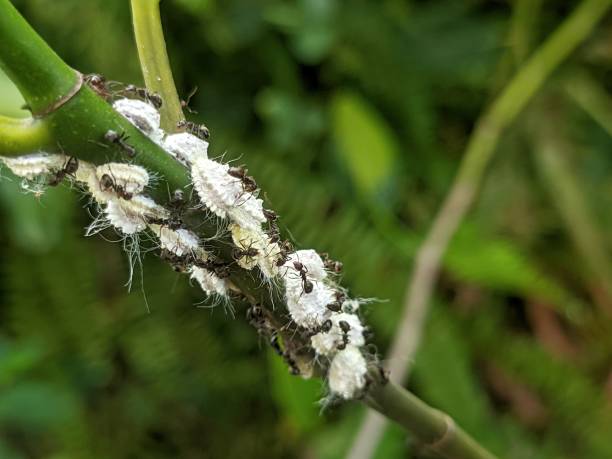
Mealybugs are dragon fruit pest which are tiny, soft-bodied insects that belong to the Hemiptera family. They look like bits of white cotton and usually gather in clusters on the stems, leaves, and sometimes even the fruits.
How Do Mealybugs Harm Dragon Fruit?
Weakening of Leaves and Stems
Mealybugs suck out the plant’s juices, causing leaves to turn yellow, develop black spots, and eventually wilt.
Poor Fruit Quality
Infected fruits often stop developing properly, show dark blemishes, and are no longer suitable for sale.
Sooty Mold Development
They excrete a sticky liquid called honeydew, which attracts a black fungus called sooty mold. This mold blocks sunlight, reducing photosynthesis.
Stunted Growth
Severe infestations can halt plant growth completely, making the cactus look dull and unhealthy.
Life Cycle of Mealybugs
- Egg – Laid in clusters and covered with a white waxy substance.
- Nymph/Larva – The young ones crawl and start feeding.
- Adult – They stay fixed and continue draining sap from the plant.
How to Spot Mealybug Infestation
- Cotton-like white clusters on leaves, stems, or fruits.
- Sticky residue or black fungus on plant surfaces.
- Leaf curling, yellowing, or general weak appearance.
How to Control Mealybugs
General Practices
- Clean your plants regularly.
- Remove infected parts immediately.
- Keep your garden tidy – fallen fruits and leaves create pest homes.
Organic Methods
- Introduce ladybugs and lacewings – natural predators.
- Use neem oil spray weekly.
- Mix a soap and water spray – it’s simple yet effective.
Mechanical Ways
- For small infections, remove them by hand using a cotton swab.
- Use strong water spray to knock them off.
Chemical Solutions
- Only use certified pesticides when other methods fail.
- Always follow safety instructions on the label.
Plant Scale: Dragon fruit pest.
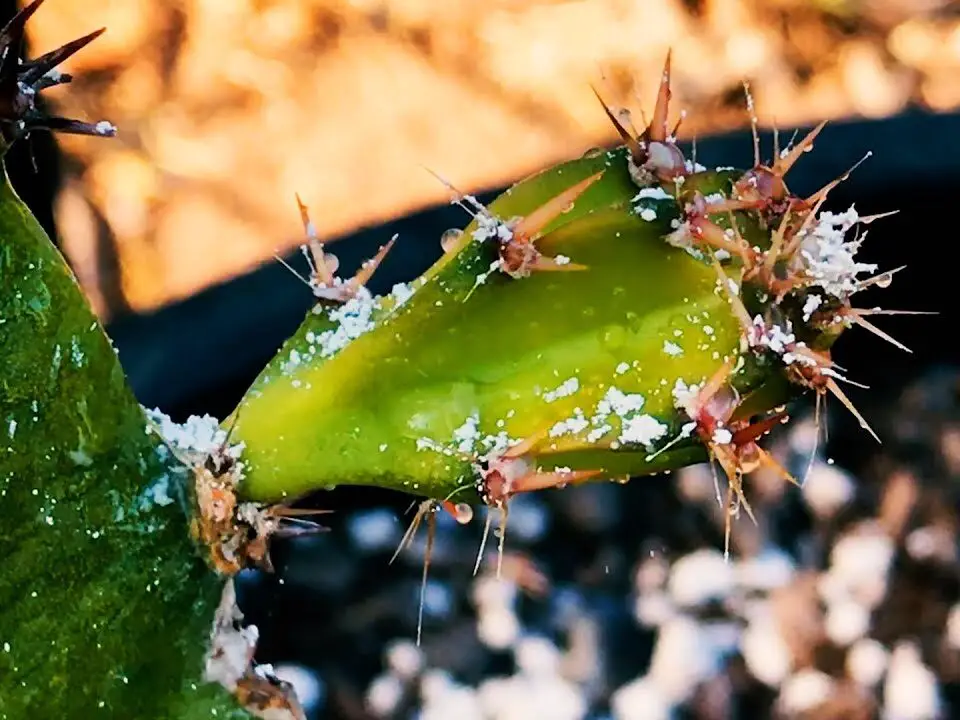
Despite looking like a plant disease, plant scales are dragon fruit dragon fruit pest and diseases which are insects too. These pests come from the Coccoidea superfamily with over 8,000 species.
How to Identify Plant Scale
Structure & Appearance
Small, flat, and disc-like insects attached to the plant’s surface.
Where They Hide
dragon fruit pest often settles on leaves and stems in large numbers.
Mold & Ant Attraction
They also release honeydew, encouraging sooty mold and attracting ants.
Impact of Plant Scale on Dragon Fruit
- Leaf yellowing and early drying.
- Reduced fruit quality.
- Visible sooty mold that blocks sunlight.
- Overall slower plant growth and stunted development.
How to Control Plant Scale dragon fruit pest and diseases
Garden Hygiene
- Remove infected branches quickly.
- Control ant colonies, as they protect scales in exchange for honeydew.
Organic Treatments
- Encourage ladybird beetles and tiny wasps (natural predators).
- Spray with neem oil weekly for prevention.
Manual & Mechanical
- Scrub off with fingers or soft brush.
- Use high-pressure water spray carefully.
Chemical Option
- Use pesticides only if the infestation is widespread and unmanageable naturally.
Sternochetus Mangiferae (Mango Seed Weevil) in Dragon Fruit
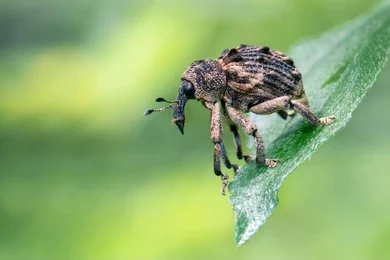
Surprising, right? The mango seed weevil is now turning up in dragon fruit fields too! This dragon fruit pest and diseases burrows into stems, leaves, and fruits, quietly ruining your yield.
Signs of Sternochetus Mangiferae
- Leaves start drying up and droop.
- Tiny holes on the fruit surface.
- Premature fruit drop.
- Discoloration of stems and leaves – yellow or brown patches.
Life Cycle of the Weevil
- Egg – Laid inside the fruit.
- Larva – Begins feeding inside.
- Pupa – Matures into adult inside the plant.
- Adult – Repeats the cycle.
How to Control Mango Seed Weevil
Cultural Practices
- Remove rotten fruits and infected plants.
- Avoid waterlogging; keep the field dry and clean.
- Clear out weeds and long grass.
Organic Controls
- Attract parasitic wasps that feed on larvae.
- Use garlic spray or neem oil.
Chemical Measures
- Use only when the infestation is uncontrollable.
- Consult a local agri-expert before spraying.
Ants: The Hidden Allies of Pests
Ants might look harmless, but they protect pests like mealybugs and scale insects because they love honeydew.
What to Do?
- Regularly apply neem oil around the plant base.
- Sprinkle diatomaceous earth around the stem base – a natural way to repel ants.
Tip of the Day: Make a Weekly Inspection Schedule
If there’s one simple habit that can save your entire dragon fruit farm from dragon fruit pest and diseases damage, it’s weekly plant inspections.
Why Weekly Inspection Works:
- Pests like mealybugs and scales don’t show up overnight — they creep in slowly.
- If you catch the first signs early (like white fluff, black spots, or tiny holes), you can stop them before they spread.
- Weekly checks give you control. It saves money on chemical pesticides and avoids huge crop losses.
Here’s how to do it:
- Pick one fixed day each week — say, every Sunday morning.
- Walk through each row of your farm with a small notepad.
- Check undersides of leaves, stem joints, and fruit surfaces.
- Look for signs like stickiness, mold, or bugs.
- If you find anything strange, act immediately — don’t wait!
Consistency is key. Make it a part of your farming routine like watering or feeding. This one step alone can be the difference between a healthy farm and a failed one.
(FAQs)
Q1. What organic sprays can I use for pest control?
You can try a homemade solution of turmeric and asafoetida (hing). Test it on 1–2 plants first. Neem oil is a safe go-to as well.
Q2. Do birds eat dragon fruit?
Yes, especially the new tender shoots. Cover young shoots with nets if bird activity is high.
Q3. Can I grow dragon fruit organically and still manage pests?
Absolutely. With regular monitoring and neem-based treatments, dragon fruit pest and diseases can be controlled without chemicals.
Q4. What time of year are pests most active?
Pest activity increases during the monsoon and early flowering stages due to high humidity.
Q5. Are chemical pesticides safe for edible fruits?
Only if used as per instructions. Always wash the fruits well before eating and avoid spraying during fruiting stage unless advised by experts.
Q6. What’s the best way to remove mealybugs manually?
Dip a cotton swab in alcohol or soap water and rub directly on them.
Q7. Can neem oil harm dragon fruit plants?
Not if diluted properly. Use 5 ml neem oil in 1 liter of water with a drop of soap.
Q8. Is it true ants “farm” mealybugs?
Yes! Ants protect mealybugs in return for honeydew. Managing ants is essential to controlling mealybugs.
Q9. How often should I use organic sprays?
Every 7–10 days during active pest seasons. Spray in early morning or evening for best results.
Q10. Do I need to treat the soil for pest control?
Yes, especially for ants and weevils. Use diatomaceous earth or wood ash around plant bases.
emiptera in Dragon fruit
